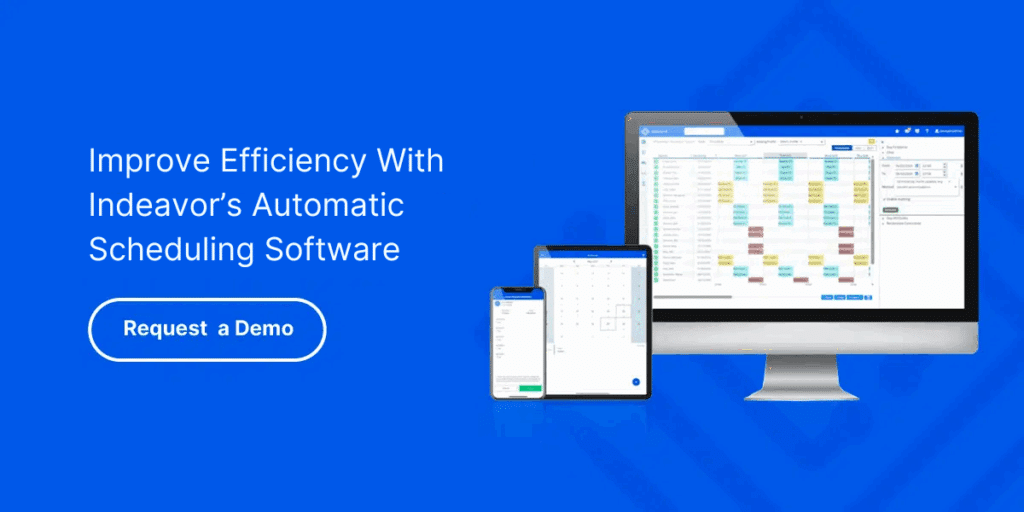Even the most advanced operations can be brought to a halt by one persistent issue: bottlenecks. When productivity stalls, customer commitments are missed, or overtime costs spiral, it’s often a bottleneck, not a major breakdown, that’s to blame. Recognizing and proactively addressing bottlenecks is one of the most effective ways to maximize performance across your workforce, facilities, and entire enterprise.
What is the Definition of a Bottleneck?
A bottleneck is a point of congestion in a production system or workflow that slows or stops the overall output. Much like how a narrow neck on a bottle restricts flow, it limits throughput by reducing the pace at which work moves through a system.
In business terms, a bottleneck often occurs when demand exceeds capacity at a particular stage of the process, whether that’s a machine, a department, or a person.
What is a Bottleneck in Business?
In a business context, a bottleneck can manifest as a delay in approvals, an employee scheduling breakdown, or a lack of labor availability. For example, if production lines are ready but there aren’t enough certified workers available to run them, labor becomes the bottleneck. These inefficiencies tend to ripple outward, slowing down delivery timelines, impacting customer satisfaction, and raising operational costs.
Only about one-third of tasks are currently automated across IT functions, according to a study by Forbes, with security, compliance, and application lifecycle management the biggest areas weighing down teams. Nearly half of the large enterprises are fulfilling key tasks manually.
The Cost of Bottlenecks in Modern Operations
Bottlenecks don’t just delay production goals; they create systemic inefficiencies that affect your entire value chain. Consider these scenarios:
- Critical equipment sits idle due to a last-minute labor call-off
- A supervisor manually adjusts shifts, delaying start times across the floor
- An employee with the required certification is available, but not scheduled where needed
Each of these situations is a labor-related bottleneck. In fact, labor is one of the most common and least visible sources of bottlenecks. The downstream impact includes increased downtime, unplanned overtime, compliance violations, and lowered throughput.
For industries operating under tight margins and regulatory oversight, these disruptions are more than just operational; they’re strategic liabilities.

What is a Bottleneck in Project Management?
In project management, a bottleneck refers to any task, dependency, or resource constraint that delays progress on the overall project timeline. This can stem from:
- Limited skilled personnel to complete a task
- Inefficient task sequencing
- Over-allocation of key resources
When labor allocation and scheduling aren’t optimized, even well-planned projects can falter. For instance, if a project depends on specialized technicians but their schedules are misaligned or managed separately across departments, the entire initiative stalls. Properly managing capacity across both daily operations and long-term projects is critical to avoiding these project-based bottlenecks.
Eliminating Bottlenecks with Smarter Labor Strategies
Many organizations try to fix bottlenecks after they’ve already impacted production. But real efficiency comes from prevention, not reaction. The key is transitioning from fragmented labor planning to a centralized, data-driven approach that prevents them before they occur.
- Build Real-Time Labor Visibility: By integrating labor data with production demand, organizations can see where constraints might form before they result in downtime. Real-time insights into coverage gaps, compliance violations, and availability give schedulers the power to shift resources and prevent a bottleneck from forming.
- Automate for Speed and Consistency: Manual scheduling is not only slow, it’s also error-prone. Automating routine processes like shift assignment, call-off backfills, and time-off approvals ensures faster, more consistent labor coverage. This eliminates human-caused delays, which are often the root of workforce delays.
- Align Labor Supply with Production Demand: Whether in a manufacturing facility or a utility plant, aligning the right person to the right place at the right time is essential. Dynamic labor forecasting based on historical demand, skills certification, and absenteeism trends helps prevent overstaffing or understaffing, both of which can contribute.
By focusing on these strategies, organizations can transform their labor management from a reactive process into a proactive system that continuously anticipates and eliminates bottlenecks, ultimately maximizing performance and operational efficiency.
Indeavor’s Role in Bottleneck Prevention
Indeavor helps large, complex organizations reduce labor-related bottlenecks by modernizing the way they plan, schedule, and deploy their workforce. With a centralized workforce management platform that automates scheduling and integrates labor data with operational needs, Indeavor gives leaders the tools to prevent them before they reduce productivity or impact services.
Key capabilities include:
- Auto-fill scheduling to ensure critical positions are never left unstaffed
- Rules-based compliance to prevent errors that lead to shift delays or reassignments
- Real-time call-off management, including 24/7 support to replace absent workers instantly
- Skills-based matching to assign the most qualified employees for each task, reducing training delays and quality issues
- Predictive labor forecasting that uses historical data and trends to anticipate demand fluctuations and adjust staffing accordingly
- Mobile scheduling and communication tools that let employees manage shifts quickly, reducing conflicts
With Indeavor, organizations move from reactive scheduling to proactive workforce planning, eliminating the most common sources of bottlenecks while optimizing performance at scale.
Stop Bottlenecks Before They Start
Bottlenecks are inevitable in any complex operation, but they don’t have to control your outcomes. Whether in daily scheduling or long-term project delivery, having the right labor strategies in place is the first step toward eliminating constraints that slow down your business.
Workforce alignment isn’t just a nice-to-have; it’s a performance multiplier. By preventing bottlenecks at the labor level, organizations can unlock greater productivity, reduce costs, and ensure smoother execution across all functions.
Learn how Indeavor can help you drive continuous improvement across your workforce. Schedule a demo today to get started.
About the Author
Claire Pieper is the Digital Marketing Specialist for Indeavor. In her role, she specializes in crafting strategic and engaging content, ensuring that customers are well-informed. Claire is dedicated to enhancing the customer experience and optimizing the user journey through Indeavor’s solutions. To learn more or get in touch, connect with Claire on LinkedIn.



